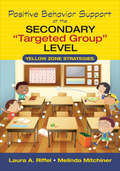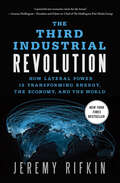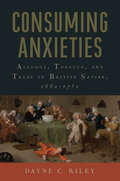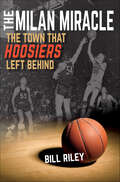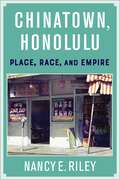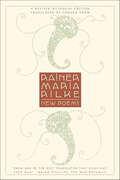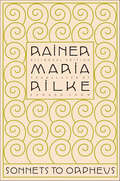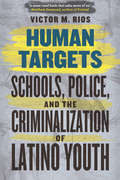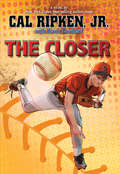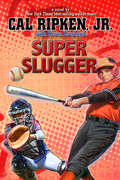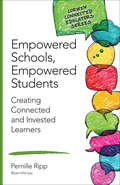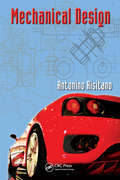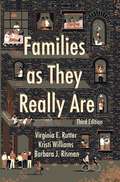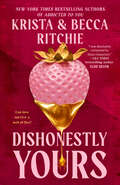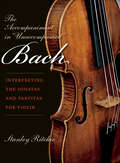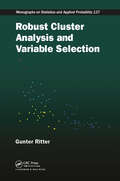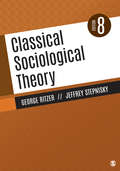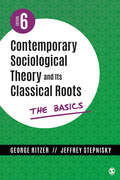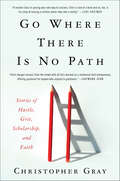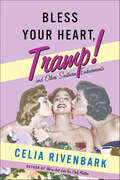- Table View
- List View
Positive Behavior Support at the Secondary "Targeted Group" Level: Yellow Zone Strategies
by Laura A. Riffel Melinda S. MitchinerSeal the gaps in student learning with targeted intervention Research on positive behavior support has focused largely on tier one, school-wide disciplinary policies, and tier three interventions tailored to highly problematic students. This leaves a gap in the middle. "Yellow zone", or tier two, interventions are an extremely effective way to address many challenging behavior and disciplinary issues in small group settings. Positive Behavior Support at the Secondary "Targeted Group" Level shows teachers how to identify the students who can benefit from tier two interventions and demonstrates how to create an implementation plan that delivers results. Focusing on proactive strategies rather than reactive solutions, Riffel and Mitchiner’s research-based techniques include: General strategies that can be applied at the individual student level, such as self-management, proximity control, and the Premack principle and peer mentoring Comprehensive action plans that anticipate the full range of disruptions that may occur A useful behavior rating sheet proven effective in improving student behavior "Funk Sway" For The Classroom: Using Feng Shui principles to create a classroom environment that enhances productivity, learning, and creativity Apply the techniques in this book to reduce challenging behavior, improve school climate, and improve outcomes for ALL students. "This book is easy to read, understand, and implement in any classroom or school. Teachers will be drawn to the resources that can be copied and used immediately! I can’t wait to apply some of these practices in my classroom!" Rachel Spenner, Sixth Grade Teacher Westridge Elementary School
The Third Industrial Revolution: How Lateral Power Is Transforming Energy, the Economy, and the World
by Jeremy RifkinThe Industrial Revolution, powered by oil and other fossil fuels, is spiraling into a dangerous endgame. The price of gas and food are climbing, unemployment remains high, the housing market has tanked, consumer and government debt is soaring, and the recovery is slowing. Facing the prospect of a second collapse of the global economy, humanity is desperate for a sustainable economic game plan to take us into the future.Here, Jeremy Rifkin explores how Internet technology and renewable energy are merging to create a powerful "Third Industrial Revolution." He asks us to imagine hundreds of millions of people producing their own green energy in their homes, offices, and factories, and sharing it with each other in an "energy internet," just like we now create and share information online.Rifkin describes how the five-pillars of the Third Industrial Revolution will create thousands of businesses, millions of jobs, and usher in a fundamental reordering of human relationships, from hierarchical to lateral power, that will impact the way we conduct commerce, govern society, educate our children, and engage in civic life.Rifkin's vision is already gaining traction in the international community. The European Union Parliament has issued a formal declaration calling for its implementation, and other nations in Asia, Africa, and the Americas, are quickly preparing their own initiatives for transitioning into the new economic paradigm.The Third Industrial Revolution is an insider's account of the next great economic era, including a look into the personalities and players — heads of state, global CEOs, social entrepreneurs, and NGOs — who are pioneering its implementation around the world.
The Zero Marginal Cost Society: The Internet of Things, the Collaborative Commons, and the Eclipse of Capitalism
by Jeremy RifkinIn The Zero Marginal Cost Society,New York Times bestselling author Jeremy Rifkin describes how the emerging Internet of Things is speeding us to an era of nearly free goods and services, precipitating the meteoric rise of a global Collaborative Commons and the eclipse of capitalism.Rifkin uncovers a paradox at the heart of capitalism that has propelled it to greatness but is now taking it to its death—the inherent entrepreneurial dynamism of competitive markets that drives productivity up and marginal costs down, enabling businesses to reduce the price of their goods and services in order to win over consumers and market share. (Marginal cost is the cost of producing additional units of a good or service, if fixed costs are not counted.) While economists have always welcomed a reduction in marginal cost, they never anticipated the possibility of a technological revolution that might bring marginal costs to near zero, making goods and services priceless, nearly free, and abundant, and no longer subject to market forces.Now, a formidable new technology infrastructure—the Internet of things (IoT)—is emerging with the potential of pushing large segments of economic life to near zero marginal cost in the years ahead. Rifkin describes how the Communication Internet is converging with a nascent Energy Internet and Logistics Internet to create a new technology platform that connects everything and everyone. Billions of sensors are being attached to natural resources, production lines, the electricity grid, logistics networks, recycling flows, and implanted in homes, offices, stores, vehicles, and even human beings, feeding Big Data into an IoT global neural network. Prosumers can connect to the network and use Big Data, analytics, and algorithms to accelerate efficiency, dramatically increase productivity, and lower the marginal cost of producing and sharing a wide range of products and services to near zero, just like they now do with information goods. The plummeting of marginal costs is spawning a hybrid economy—part capitalist market and part Collaborative Commons—with far reaching implications for society, according to Rifkin. Hundreds of millions of people are already transferring parts of their economic lives to the global Collaborative Commons. Prosumers are plugging into the fledgling IoT and making and sharing their own information, entertainment, green energy, and 3D-printed products at near zero marginal cost. They are also sharing cars, homes, clothes and other items via social media sites, rentals, redistribution clubs, and cooperatives at low or near zero marginal cost. Students are enrolling in free massive open online courses (MOOCs) that operate at near zero marginal cost. Social entrepreneurs are even bypassing the banking establishment and using crowdfunding to finance startup businesses as well as creating alternative currencies in the fledgling sharing economy. In this new world, social capital is as important as financial capital, access trumps ownership, sustainability supersedes consumerism, cooperation ousts competition, and "exchange value" in the capitalist marketplace is increasingly replaced by "sharable value" on the Collaborative Commons. Rifkin concludes that capitalism will remain with us, albeit in an increasingly streamlined role, primarily as an aggregator of network services and solutions, allowing it to flourish as a powerful niche player in the coming era. We are, however, says Rifkin, entering a world beyond markets where we are learning how to live together in an increasingly interdependent global Collaborative Commons.
Consuming Anxieties: Alcohol, Tobacco, and Trade in British Satire, 1660-1751 (Transits: Literature, Thought & Culture, 1650-1850)
by Dayne C. RileyWriters of the late seventeenth and early eighteenth centuries—a period of vast economic change—recognized that the global trade in alcohol and tobacco promised a brighter financial future for England, even as overindulgence at home posed serious moral pitfalls. This engaging and original study explores how literary satirists represented these consumables—and related anxieties about the changing nature of Britishness—in their work. Riley traces the satirical treatment of wine, beer, ale, gin, pipe tobacco, and snuff from the beginning of Charles II’s reign, through the boom in tobacco’s popularity, to the end of the Gin Craze in libertine poems and plays, anonymous verse, ballad operas, and the satire of canonical writers such as Gay, Pope, and Swift. Focusing on social concerns about class, race, and gender, Consuming Anxieties examines how satirists championed Britain’s economic strength on the world stage while critiquing the effects of consumable luxuries on the British body and consciousness.
The Milan Miracle: The Town that Hoosiers Left Behind
by Lt. Col. Bill RileyWill lightning ever strike twice? Can David beat Goliath a second time? These questions haunt everyone in the small town of Milan, Indiana, whose basketball team inspired Hoosiers, the greatest underdog sports movie ever made. From a town of just 1,816 residents, the team remains forever an underdog, but one with a storied past that has them eternally frozen in their 1954 moment of glory. Every ten years or so, Milan has a winning season, but for the most part, they only manage a win or two each year. And still, perhaps because it's the only option for Milan, the town believes that the Indians can rise again. Bill Riley follows the modern day Indians for a season and explores how the Milan myth still permeates the town, the residents, and their high level of expectations of the team. Riley deftly captures the camaraderie between the players and their coach and their school pride in being Indians. In the end, there are few wins or causes for celebration—there is only the little town where basketball is king and nearly the whole town shows up to watch each game. The legend of Milan and Hoosiers is both a blessing and a curse.
Chinatown, Honolulu: Place, Race, and Empire
by Nancy E. RileyThe Chinese experience in Hawai‘i has long been told as a story of inclusion and success. During the Cold War, the United States touted the Chinese community in Hawai‘i as an example of racial harmony and American opportunity, claiming that all ethnic groups had the possibility to attain middle-class lives. Today, Honolulu’s Chinatown is not only a destination for tourism and consumption but also a celebration of Chinese accomplishments, memorializing past discrimination and present prominence within a framework of multiculturalism. This narrative, however, conceals many other histories and processes that played crucial roles in shaping Chinatown.This book offers a critical account of the history of Chinese in Hawai‘i from the mid-nineteenth century to the present in this context of U.S. empire, settler colonialism, and racialization. Nancy E. Riley foregrounds elements that are often left out of narratives of Chinese history in Hawai‘i, particularly the place of Native Hawaiians, geopolitics and U.S. empire building, and the ongoing construction of race and whiteness. Tracing how Chinatown became a site of historical remembrance, she argues that it is also used to reinforce the ideology of neoliberal multiculturalism, which upholds racial hierarchy by lauding certain ethnic groups while excluding others. An insightful and in-depth analysis of the story of Honolulu’s Chinatown, this book offers new perspectives on the making of the racial landscape of Hawai‘i and the United States more broadly.
New Poems: A Revised Bilingual Edition (Studies In German Literature Linguistics And Culture Ser. #164)
by Rainer Maria RilkeThe formative work of the legendary poet who sought to write "not feelings but things I had felt"When Rainer Maria Rilke arrived in Paris for the first time in September 1902, commissioned by a German publisher to write a monograph on Rodin, he was twenty-seven and already the author of nine books of poems. His early work had been accomplished, but belonged tonally to the impressionistic, feeling-centered world of a late-nineteenth-century aesthetic.Paris was to change everything. Rilke's interest in Rodin deepened and his enthusiasm for the sculptor's "art of living surfaces" set the course for his own pursuit of an objective ideal. What was "new" about Rilke's New Poems, published in two independent volumes in 1907 and 1908, is a compression of statement and a movement away from "expression" and toward "making realities." Poems such as "The Panther" and "Archaic Torso of Apollo" are among the most successful and famous results of Rilke's impulse.This selection from both books unites the companion volumes in a torrent of brilliant work intoxicated with the materiality of the world. Edward Snow has now improved upon the translations for which he received the Harold Morton Landon Translation Award and with which he began his twenty-year project of translating Rilke.
Sonnets to Orpheus: (bilingual Edition)
by Rainer Maria RilkeBreathing, you invisible poem!World-space in pure continuous interchangewith my own being. Equiposein which I rhythmically transpire.Written only four years before Rilke's death, this sequence of sonnets, varied in form yet consistently structured, stands as the poet's final masterwork. In these meditations on the constant flux of our world and the ephemerality of experience, Rilke envisions death not only as one among many of life's transformations but also as an ideally receptive state of being. Because Orpheus has visited the realm of death and returned to the living, his lyre, a unifying presence in these poems, is an emblem of fluidity and musical transcendence. And Eurydice, condemned to Hades as a result of Orpheus's backward glance, becomes in Rilke's universe a mythical figure of consolation and hope.Edward Snow, in his translations of New Poems, The Book of Images, Uncollected Poems, and Duino Elegies, has emerged as Rilke's most able English-language interpreter. Adhering faithfully to the intent of Rilke's German while constructing nuanced, colloquial poems in English, Snow's Sonnets to Orpheus should serve as the authoritative translation for years to come.
Human Targets: Schools, Police, and the Criminalization of Latino Youth
by Victor M. RiosAt fifteen, Victor Rios found himself a human target—flat on his ass amid a hail of shotgun fire, desperate for money and a place on the street. Faced with the choice of escalating a drug turf war or eking out a living elsewhere, he turned to a teacher, who mentored him and helped him find a job at an auto shop. That job would alter the course of his whole life—putting him on the road to college and eventually a PhD. Now, Rios is a rising star, hailed for his work studying the lives of African American and Latino youth. In Human Targets, Rios takes us to the streets of California, where we encounter young men who find themselves in much the same situation as fifteen-year-old Victor. We follow young gang members into schools, homes, community organizations, and detention facilities, watch them interact with police, grow up to become fathers, get jobs, get rap sheets—and in some cases get killed. What is it that sets apart young people like Rios who succeed and survive from the ones who don’t? Rios makes a powerful case that the traditional good kid/bad kid, street kid/decent kid dichotomy is much too simplistic, arguing instead that authorities and institutions help create these identities—and that they can play an instrumental role in providing young people with the resources for shifting between roles. In Rios’s account, to be a poor Latino youth is to be a human target—victimized and considered an enemy by others, viewed as a threat to law enforcement and schools, and burdened by stigma, disrepute, and punishment. That has to change. This is not another sensationalistic account of gang bangers. Instead, the book is a powerful look at how authority figures succeed—and fail—at seeing the multi-faceted identities of at-risk youths, youths who succeed—and fail—at demonstrating to the system that they are ready to change their lives. In our post-Ferguson era, Human Targets is essential reading.
The Closer (Cal Ripken Jr.'s All Stars #6)
by Cal Ripken Jr.The final book in the out-of-the-park series by legendary short-stop and a veteran sportswriter Cal Ripkin.Danny Connolly is a back-up pitcher with the Dulaney Orioles. He knows what that means: not good enough to start. When he does get into games, he hasn't exactly been the shut-down reliever the team needs. To make matters worse, he's playing in the shadow of his older brother, Joey, a lights-out high school lefty with a 90-mph fastball who's attracting lots of attention from college recruiters and major league scouts. It's bad enough that Danny's parents seem to fawn over Joey and barely talk about what Danny does in his games. But now, as his big brother's mound exploits draw more and more attention, Danny's starting to get the why-aren't-you-as-good-as-Joey comments from the Orioles, too. The pressure to live up to Joey's success is stifling.Lonely and frustrated, Danny embarks on a secret project designed to make his family and teammates sit up and take notice. Aided by a mysterious stranger with an uncanny knowledge of the aerodynamics of a thrown baseball, he attempts to learn a new pitch. A pitch no one has ever seen before. The clock is ticking on Danny as the O's try to repeat as league champions. But if his audacious plan works and he can master the magical fluttering pitch known as "The Terminator," he'll soon be the talk of the league -- and the dependable closer the Orioles desperately need.
Super Slugger (Cal Ripken Jr.'s All Stars #2)
by Cal Ripken Jr.Cody Parker is the new kid in school. He's overweight, scared and hates his new life in Dullsville, Maryland, aka Baltimore, where he's a target okay, a big target for brutal teasing. But he loves baseball. And despite his size, he plays third base like a dream. Too bad he's competing for the starting job on the Orioles of the Dulaney Babe Ruth League against budding hoodlum Dante Rizzo, who vows to squeeze Cody's head like a grape if he beats him out. Life gets even more complicated when Cody's school, York Middle, is beset by a rash of mysterious thefts, a crime wave that threatens to sideline Cody and ruin a golden season for the Orioles. Will Cody ever succeed in getting people to see him for who he really is?
Empowered Schools, Empowered Students: Creating Connected and Invested Learners (Corwin Connected Educators Series)
by Pernille S. RippOpen up a new world of learning and engage students with these powerful ideas! This book helps you empower teachers and students to regain control of their own teaching and learning journey. With this helpful guide, cultivate enthusiasm for learning by changing the power dynamic and putting the reins back into the hands of students. Administrators and teachers learn to: Cultivate the experts at your school Create an environment of trust and collaboration Give students and staff a voice Includes real-life stories from other connected educators! Transform the learning experience and create lasting change with this breakthrough volume of the Connected Educators Series! The Corwin Connected Educators series is your key to unlocking the greatest resource available to all educators: other educators. Being a Connected Educator is more than a set of actions: it’s a belief in the potential of technology to fuel lifelong learning. "Pernille has shared what it takes to create an environment that nurtures growth for students and staff." —Nicholas Provenzano, The Nerdy Teacher TheNerdyTeacher.com @TheNerdyTeacher "Pernille makes a case for the need to change from a traditional hierarchical approach of control to a shared, empowering approach. This book outlines steps that administrators can take to share leadership in their schools and teachers can take to share the responsibility of learning with the students." —William Chamberlain, Teacher Noel Elementary School
Empowered Schools, Empowered Students: Creating Connected and Invested Learners (Corwin Connected Educators Series)
by Pernille S. RippOpen up a new world of learning and engage students with these powerful ideas! This book helps you empower teachers and students to regain control of their own teaching and learning journey. With this helpful guide, cultivate enthusiasm for learning by changing the power dynamic and putting the reins back into the hands of students. Administrators and teachers learn to: Cultivate the experts at your school Create an environment of trust and collaboration Give students and staff a voice Includes real-life stories from other connected educators! Transform the learning experience and create lasting change with this breakthrough volume of the Connected Educators Series! The Corwin Connected Educators series is your key to unlocking the greatest resource available to all educators: other educators. Being a Connected Educator is more than a set of actions: it’s a belief in the potential of technology to fuel lifelong learning. "Pernille has shared what it takes to create an environment that nurtures growth for students and staff." —Nicholas Provenzano, The Nerdy Teacher TheNerdyTeacher.com @TheNerdyTeacher "Pernille makes a case for the need to change from a traditional hierarchical approach of control to a shared, empowering approach. This book outlines steps that administrators can take to share leadership in their schools and teachers can take to share the responsibility of learning with the students." —William Chamberlain, Teacher Noel Elementary School
Mechanical Design
by Antonino RisitanoWith a focus on the Italian School of machine design as founded by R. Giovannozzi of Turin Polytechnic, this book provides a complete picture of the necessary components of design, along with the necessary instruments for implementation. It also explains the method of the compact modeling analysis of the mechanical problem. The book provides details from simple fundamentals, to explanation of the design of traditional mechanical components. Topics covered include the methodological statement of engineering, properties of engineering materials, and the design of mechanical components and systems. Case studies are included for the different themes.
Families as They Really Are (Third Edition)
by Barbara J RismanThis purchase offers access to the digital ebook only.
Dishonestly Yours (Webs We Weave #1)
by Krista Ritchie Becca RitchieStarting fresh is the only way Phoebe can escape a life of crime, but her best friend's older brother complicates honest dreams in this gripping new series from the authors of the Addicted series.Phoebe Graves grew up in a family where deception and seduction are as commonplace as breathing. The Graves and her best friend Hailey&’s family have been on the run their whole lives, but after a high-stakes con job goes south, Phoebe and Hailey decide to run away and start over. The small Connecticut town they settle in seems too good to be true.The biggest flaw in their plan is Hailey&’s frustratingly handsome brother, Rocky, who insists on coming with them. Living honestly isn&’t in his DNA, and his past with Phoebe is downright messy. He&’s everything she wants, but nothing she can have. Phoebe worries that Rocky will tempt them back into their old ways, where lying is second nature. She doesn&’t want Rocky to mess up the new life she&’s begun for herself. The longer she stays in town, the more she realizes what it means to have a reputation—and what a normal life with the man she loves could look like.
The Accompaniment in "Unaccompanied" Bach: Interpreting the Sonatas and Partitas for Violin (Publications of the Early Music Institute)
by Stanley RitchieKnown around the world for his advocacy of early historical performance and as a skilled violin performer and pedagogue, Stanley Ritchie has developed a technical guide to the interpretation and performance of J. S. Bach's enigmatic sonatas and partitas for solo violin. Unlike typical Baroque compositions, Bach's six solos are uniquely free of accompaniment. To add depth and texture to the pieces, Bach incorporated various techniques to bring out a multitude of voices from four strings and one bow, including arpeggios across strings, multiple stopping, opposing tonal ranges, and deft bowing. Published in 1802, over 80 years after its completion in 1720, Bach's manuscript is without expression marks, leaving the performer to freely interpret the dynamics, fingering, bowings, and articulations. Marshaling a lifetime of experience, Stanley Ritchie provides violinists with deep insights into the interpretation and technicalities at the heart of these challenging pieces.
Robust Cluster Analysis and Variable Selection (ISSN)
by Gunter RitterClustering remains a vibrant area of research in statistics. Although there are many books on this topic, there are relatively few that are well founded in the theoretical aspects. In Robust Cluster Analysis and Variable Selection, Gunter Ritter presents an overview of the theory and applications of probabilistic clustering and variable selection,
American Conspiracism: An Interdisciplinary Exploration
by Luke RitterThis important collection explores the social effects of popular American conspiratorial beliefs, featuring the work of 22 scholars representing multiple academic disciplines.This book aims to better understand the phenomenon of American conspiracism by investigating how people acquire their beliefs, how conspiratorial stories function in politics and society, the role of conspiracy theories in the formation of national identities, and what conspiratorial beliefs mean to individual believers. Topics include QAnon, the Boogaloo Boys, the satanic panic, the Martin Luther King, Jr. Assassination, the Great Replacement Theory, anti-Catholic nativism, Flat Earth belief, Elvis Lives, COVID-19 denial, and much more. Each essay is accessibly and engagingly written without compromising quality.American Conspiracism is essential reading for students of psychology, political science, and U.S. history, as well as journalists, independent researchers, and anyone interested in American conspiracies.
Classical Sociological Theory
by George Ritzer Jeffrey N. StepniskyThe authors are proud sponsors of the 2020 SAGE Keith Roberts Teaching Innovations Award—enabling graduate students and early career faculty to attend the annual ASA pre-conference teaching and learning workshop. Classical Sociological Theory, Eighth Edition, provides a comprehensive overview of the major theorists and schools of sociological thought from the Enlightenment roots of theory through the early 20th century. The integration of key theories with biographical sketches of theorists and the requisite historical and intellectual context helps students to better understand the original works of classical authors as well as to compare and contrast classical theories.
Classical Sociological Theory
by George Ritzer Jeffrey N. StepniskyThe authors are proud sponsors of the 2020 SAGE Keith Roberts Teaching Innovations Award—enabling graduate students and early career faculty to attend the annual ASA pre-conference teaching and learning workshop. Classical Sociological Theory, Eighth Edition, provides a comprehensive overview of the major theorists and schools of sociological thought from the Enlightenment roots of theory through the early 20th century. The integration of key theories with biographical sketches of theorists and the requisite historical and intellectual context helps students to better understand the original works of classical authors as well as to compare and contrast classical theories.
Contemporary Sociological Theory and Its Classical Roots: The Basics
by George Ritzer Jeffrey N. StepniskyContemporary Sociological Theory and Its Classical Roots: The Basics, is a brief survey of sociology′s major theorists and theoretical approaches, from the Classical founders to the present. The content is adapted from Ritzer/Stepnisky, Sociological Theory, and the authors connect many theorists together into chapters with broad headings (Contemporary Integrative Theories, Contemporary Theories of Everyday Life, etc.) that offer students a big-picture, synthesized view of sociological theory. Because of its size, price, and flexible organization, the text can be used in a variety of undergraduate sociological theory classes: Classical, Contemporary, or Combined.
Contemporary Sociological Theory and Its Classical Roots: The Basics
by George Ritzer Jeffrey N. StepniskyContemporary Sociological Theory and Its Classical Roots: The Basics, is a brief survey of sociology′s major theorists and theoretical approaches, from the Classical founders to the present. The content is adapted from Ritzer/Stepnisky, Sociological Theory, and the authors connect many theorists together into chapters with broad headings (Contemporary Integrative Theories, Contemporary Theories of Everyday Life, etc.) that offer students a big-picture, synthesized view of sociological theory. Because of its size, price, and flexible organization, the text can be used in a variety of undergraduate sociological theory classes: Classical, Contemporary, or Combined.
Go Where There Is No Path: Stories of Hustle, Grit, Scholarship, and Faith
by Mim Eichler Rivas Christopher GrayFor all who dare to go off the beaten track, this is the inspirational, power-packed playbook for transforming your life and your world—from a young, Black social entrepreneur whose dorm-room tech startup has helped millions pay for college and access unprecedented opportunity. Gray, the son of a single working mother who had him at age fourteen, grew up in deep poverty in Birmingham, Alabama. An academic star, he had every qualification for attending a top college—except for the financial means. Desperate, Gray headed off the beaten path, searching online to apply for every scholarship he could find. His hustle resulted in awards of 1.3 million dollars and became his call to action to help other students win their own “schollys.” It inspired him to start up Scholly, an app that matches college applicants with millions of dollars in outside scholarships that often go unclaimed. When he was a senior at Drexel University, he appeared on Shark Tank as CEO of Scholly. In the most heated fight in the show’s history, the sharks challenged Gray as to whether his app was a charity or a profitable business. Both, he insisted, proposing a new paradigm for social entrepreneurship and netting deals from Lori Grenier and Daymond John. At the time Scholly’s subscriber base was 90,000 users. Today the app has 4 million subscribers who have won scholarships totaling more than $100 million. Meanwhile, Gray—without help from the mostly all-white boy’s club of Silicon Valley—has emerged as a tech startup superhero now tackling the crisis of student debt with innovative, unrivaled strategies. Gray’s premise is that when you lead with the good—confronting issues such as poverty and racism—the money will follow. His story is proof that when you develop a mindset for success, you turn disadvantages into gold. And when you create opportunities for others, you enrich the marketplace for yourself too. Gray shows us, we can carve out new paths to better days and leave trails for others.
Bless Your Heart, Tramp!: And Other Southern Endearments
by Celia RivenbarkFrom the wickedly hilarious pen of Southern humorist Celia Rivenbark comes a collection of essays that brings to mind Dave Barry (in high heels) or Jeff Foxworthy (in a prom dress).Step into the wacky world of "womanless wedding" fund-raisers, in which Bubbas wear boas. Meet two sisters who fight rural boredom by washing Budweiser cans and cutting them into pieces to make clothing. Learn why the word snow sends any right-thinking Southerner careening to the Food Lion for extra loaves of bread and little else. Humor columnist and slightly crazed belle-by-birth Celia Rivenbark tackles these and other lard-laden subjects in Bless Your Heart, Tramp, a hilarious look at Southern---and just plain human---foibles, up-close and personal. So pour yourself a glass of sweet tea and curl up on the pie-azza with Bless Your Heart, Tramp.
